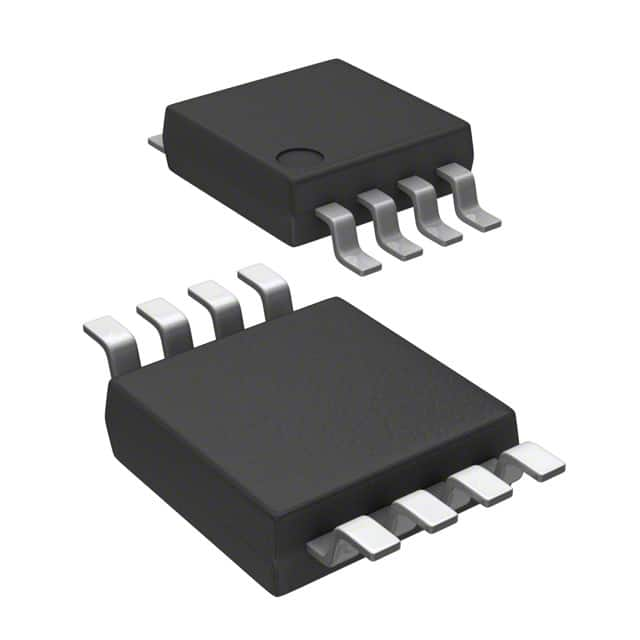Viz Specifikace pro podrobnosti o produktu.

PIC12F615-E/MS
Product Overview
Category
The PIC12F615-E/MS belongs to the category of microcontrollers.
Use
This microcontroller is commonly used in various electronic devices and systems for controlling and processing data.
Characteristics
- Low power consumption
- High-performance RISC CPU
- Flash program memory
- EEPROM data memory
- Analog-to-digital converter (ADC)
- Timers and PWM modules
- Serial communication interface
- Small form factor
Package
The PIC12F615-E/MS is available in a surface mount package, specifically the MSOP-8 package.
Essence
The essence of the PIC12F615-E/MS lies in its ability to provide efficient control and processing capabilities in a compact and low-power package.
Packaging/Quantity
This microcontroller is typically packaged in reels or tubes, with quantities varying based on customer requirements.
Specifications
- CPU Speed: 4 MHz
- Program Memory Size: 1.75 KB
- RAM Size: 64 bytes
- Data EEPROM Size: 128 bytes
- ADC Resolution: 10-bit
- Number of I/O Pins: 6
- Operating Voltage Range: 2.0V to 5.5V
- Temperature Range: -40°C to +125°C
Detailed Pin Configuration
The PIC12F615-E/MS has a total of 8 pins, each serving a specific purpose. The pin configuration is as follows:
- VDD - Power supply voltage input
- GP0 - General-purpose I/O pin
- GP1 - General-purpose I/O pin
- GP2 - General-purpose I/O pin
- GP3 - General-purpose I/O pin
- GP4 - General-purpose I/O pin
- GP5 - General-purpose I/O pin
- VSS - Ground
Functional Features
- High-performance RISC CPU for efficient data processing
- Flash program memory for storing the program code
- EEPROM data memory for non-volatile storage
- Analog-to-digital converter (ADC) for converting analog signals to digital values
- Timers and PWM modules for precise timing and control
- Serial communication interface for data exchange with other devices
Advantages and Disadvantages
Advantages
- Low power consumption, making it suitable for battery-powered applications
- Compact size allows for integration into space-constrained designs
- Wide operating voltage range provides flexibility in various power supply scenarios
- Rich set of peripherals and features enable versatile application development
Disadvantages
- Limited program memory size may restrict the complexity of applications
- Limited number of I/O pins may limit the connectivity options in certain designs
Working Principles
The PIC12F615-E/MS operates based on the principles of a microcontroller. It executes instructions stored in its program memory, processes data, and interacts with external devices through its I/O pins. The CPU fetches instructions, decodes them, and performs the necessary operations to achieve the desired functionality.
Detailed Application Field Plans
The PIC12F615-E/MS finds applications in various fields, including but not limited to: - Home automation systems - Industrial control systems - Automotive electronics - Consumer electronics - Medical devices - Internet of Things (IoT) devices
Detailed and Complete Alternative Models
- PIC12F609
- PIC12F617
- PIC12F629
- PIC12F635
- PIC12F683
These alternative models offer similar functionalities and can be considered as substitutes for the PIC12F615-E/MS depending on specific requirements.
In conclusion, the PIC12F615-E/MS is a versatile microcontroller that offers low power consumption, compact size, and a rich set of features. Its wide range of applications and availability of alternative models make it a popular choice for various electronic systems and devices.
Word count: 511
Seznam 10 běžných otázek a odpovědí souvisejících s aplikací PIC12F615-E/MS v technických řešeních
What is the maximum operating frequency of PIC12F615-E/MS?
- The maximum operating frequency of PIC12F615-E/MS is 20 MHz.
What are the key features of PIC12F615-E/MS?
- PIC12F615-E/MS features 1.75KB Flash Program Memory, 64B RAM, 128 bytes of EEPROM data memory, and more.
Can PIC12F615-E/MS be used for motor control applications?
- Yes, PIC12F615-E/MS can be used for simple motor control applications.
What communication interfaces does PIC12F615-E/MS support?
- PIC12F615-E/MS supports SPI and I2C communication interfaces.
Is PIC12F615-E/MS suitable for battery-powered applications?
- Yes, PIC12F615-E/MS is suitable for battery-powered applications due to its low power consumption.
Does PIC12F615-E/MS have analog-to-digital conversion (ADC) capabilities?
- Yes, PIC12F615-E/MS has a 10-bit ADC module.
What development tools are available for programming PIC12F615-E/MS?
- Development tools such as MPLAB X IDE and PICkit programmers can be used to program PIC12F615-E/MS.
Can PIC12F615-E/MS be used in automotive electronics applications?
- Yes, PIC12F615-E/MS can be used in various automotive electronics applications.
What are the available package options for PIC12F615-E/MS?
- PIC12F615-E/MS is available in 8-pin PDIP, SOIC, and MSOP packages.
Are there any application notes or reference designs available for PIC12F615-E/MS?
- Yes, Microchip provides application notes and reference designs for using PIC12F615-E/MS in various technical solutions.

